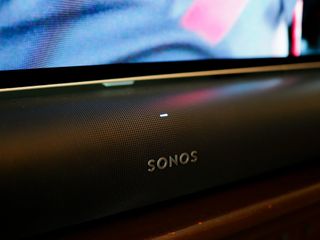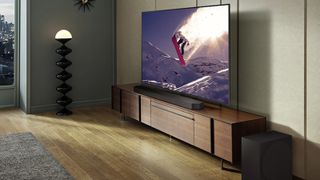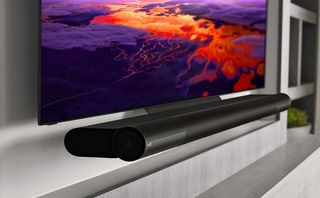Best Dolby Atmos Soundbars 2024
Surround sound with less hassle

True Dolby Atmos setups require you to place between 8 and 12 speakers throughout your living room—including up to four mounted on your ceiling. Just because you want convincing surround sound, doesn't mean you want to cut holes in your ceiling making something like the Samsung Q800C soundbar and subwoofer a great solution for many. This soundbar has a upward firing speakers as well as a center channel for strong directional audio.
Upgrade your home with an Atmos soundbar
Why you can trust Android Central

Samsung Q-series 5.1.2 ch Q800C
Reasons to buy
Reasons to avoid
The Samsung Q800C is a soundbar and subwoofer package that's part of Samsung's high-end Q-series of soundbars. This 11-speaker unit has a 5.1.2 layout with an 8-inch wireless subwoofer. That's two speakers for the left, two more on the right, a center channel, subwoofer, and two up-firing speakers. If you have a supported Samsung TV, Q Symphony can even use your TV's speakers to help out with audio.
With Atmos and Samsung's SpaceFit Sound Pro, the system will optimize its audio for your room. This is useful as this soundbar can bounce the audio from the side and up-firing speakers off of the walls and ceiling, which can vary by room. You can set sound modes to optimize for the content type as well, such as sports, news, and movies. It can also boost dialog if you're having trouble hearing people speak.
While a soundbar like this is able to deliver impressive surround sound from a single unit, you can get a richer and more direction sound with some more speakers. Samsung's wireless rear speakers, the SWA-9500S can be added to improve sounds that come from behind you.

Sony HT-G700 3.1 ch Soundbar with Subwoofer
Reasons to buy
Reasons to avoid
For the most part with Atmos, more is better when it comes to speakers. One of the best things about Atmos, however, is its ability to create a surround sound experience with fewer speakers when necessary. Sony also uses its own tech called S-Force Pro Front Surround and the Vertical Surround Engine to make it sound like audio is coming from behind or above you.
This soundbar is a simple 3.1 layout with a left, right, and center speaker. A center speaker is important because it can help keep dialog audio clear, even when there are a lot of sound effects in the left and right channels. While speakers are able to produce a wide range of frequencies at once, adding more speakers can help improve clarity.
Like most soundbars, you can also stream music to it with Bluetooth so you don't need a separate speaker in the room. Connection for your TV is easy with HDMI eARC, 4K HDMI passthrough, and optical. Even if your TV is a few years old, it should work with this soundbar.

LG S75Q 3.1.2 ch Soundbar
Reasons to buy
Reasons to avoid
The LG S75Q isn't exactly a premium soundbar, but it has focused on some of the most important features making it one of the best values you can get with Atmos. This 3.1.2 ch soundbar has a left, right, and center speakers on the front with two up-firing speakers on top. The left, right, and center speakers are 30W each and the top speaker on top are 35W each. The subwoofer isn't huge at six inches and 220W, but should be a good size for this soundbar.
This soundbar supports Bluetooth audio for wireless support and is quickly set up with LG Sound Sync on some LG TVs. For everyone else, there's optical input for older TVs and HDMI passthrough with eARC support so you're hooked up with just once cable. With a lot of power on deck and its two up-firing speakers, the LG S75Q punches above its weight with plenty of power for even a large room.

Sonos Arc
Reasons to buy
Reasons to avoid
Straight out of the box, the Sonos Arc is petite enough to slot beneath most TVs (or can be mounted), doesn't take long to set up, and has no peripherals to connect to it. While it lacks discrete speakers or a subwoofer, the all-in-one design compensates for this with eight woofers, three tweeters, and 11 amplifiers, as well as Sonos' Trueplay Tuning tool—which tunes these drivers to match the specific dimensions of your living room.
Our review found the audio quality to be truly top-notch, and was impressed with its ability to isolate distinct sounds with Atmos-enabled content. Still, how well your Arc performs will depend in part on the room it's in. In a smaller, enclosed space, it can easily use drivers to guide sound objects into an impressive 3D bubble. In a larger or wider room, no soundbar on its own is going to perfectly recreate surround sound. Most buyers are just looking for an upgrade on TV speakers, however, and will find the Arc perfectly fulfills this role.
One caveat of the Arc is its single HDMI port and missing Bluetooth support. Most soundbars feature two or more HDMI slots, which allows you to directly connect other devices to your soundbar besides your television. With the Arc, all sound data must run through your TV, meaning if you have an older TV, it will limit your Arc's capacity to produce good sound or properly sync audio and video. Essentially, make sure you have a recent 4K TV if you want features like eARC to work properly.

Sennheiser Ambeo Max
Reasons to buy
Reasons to avoid
We won't beat around the bush: only the wealthiest of sound snobs should consider Sennheiser Ambeo Max Soundbar, which sells for more than double most of the other soundbars on this list. At nearly half a foot tall, this behemoth can squeeze in 13 large drivers that create the most impressive surround sound you could hope for in an all-in-one device. It's so large, in fact, that you're basically required to mount your TV so it can fit underneath it.
Most people spending over two grand on a sound system would invest in a hardcore home theater and litter their living room with speakers. Yet Sennheiser does an admirable job of imitating an actual surround-sound layout with the Ambeo while leaving floor and table space for something besides speakers.
The Ambeo supports most audio formats and connections that you could ask for, including DTS:X, HDMI 2.1, eARC, 4K video pass-through, 3 HDMI inputs, Chromecast, multiband EQ, and more. Plus, it has a custom microphone that maps out your room to calibrate the sound perfectly.

VIZIO Elevate Soundbar (P514a-H6)
Reasons to buy
Reasons to avoid
While many speakers require you to choose its Dolby Atmos setting manually, the Vizio Elevate automatically detects soundtracks with Atmos or DTS:X objects and rotates its speaker pods towards the ceiling for proper 3D audio. Then, they switch back to forward-firing surround-sound by default for regular tracks.
Specs-wise, it more than matches the competition: 18 speakers including four up-firing speakers, adjustable dialogue EQ, 4K Dolby Vision HDR Pass-Through, 8-inch wireless subwoofer, and voice assistant support for Alexa, Siri, and Google Assistant. It also upgrades to HDMI 2.1 eARC, which allows for speedier transfer of uncompressed audio data and perfect syncing of video and audio to remove any lag.
Get the right soundbar for your room
Comparing most of these devices, it's surprising how similar most of these soundbars are in terms of features and specs. Certainly, the all-in-one versus four-speaker difference is important, and audiophiles will dislike certain missing features like DTS:X or enough HDMI ports. But ultimately, this list is chock-full of excellent audio quality, and you get diminishing returns the higher the list price climbs with the most significant upgrades requiring surround speakers.
The Samsung Q800C is one of our favorites thanks to Samsung's design expertise and solid specs. This soundbar has a ton of speakers so Dolby Atmos has the resources needed to create convince surround sound. If you pair it with one of the best Samsung TVs with Q Symphony support, you can even use your TV speakers in your surround setup.
Be an expert in 5 minutes
Get the latest news from Android Central, your trusted companion in the world of Android

Michael is Android Central's resident expert on fitness tech and wearables, with an enthusiast's love of VR tech on the side. After years freelancing for Techradar, Wareable, Windows Central, Digital Trends, and other sites on a variety of tech topics, AC has given him the chance to really dive into the topics he's passionate about. He's also a semi-reformed Apple-to-Android user who loves D&D, Star Wars, and Lord of the Rings.
For wearables, Michael has tested dozens of smartwatches from Garmin, Fitbit, Samsung, Apple, COROS, Polar, Amazfit, and other brands, and will always focus on recommending the best product over the best brand. He's also completed marathons like NYC, SF, Marine Corps, Big Sur, and California International — though he's still trying to break that 4-hour barrier.
